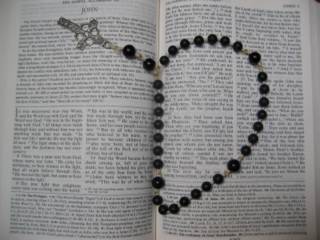Texanglican
"The Preachers chiefly shall take heed that they teach nothing in their preaching, which they would have the people religiously to observe and believe, but that which is agreeable to the Doctrine of the Old Testament and the New, and that which the Catholick Fathers and Ancient Bishops have gathered out of that Doctrine." A proposed canon of Elizabeth I, 1571
About Me

- Name: Texanglican (R.W. Foster+)
- Location: Bedford, Texas, United States
I am a presbyter in the diocese of Fort Worth, Texas (Anglican Church in North America). I serve as Chaplain at St. Vincent's School and as a canon of St. Vincent's Cathedral Church in Bedford, Texas. In addition to my parish duties and teaching Religion classes in the school I am also the Middle School Social Studies teacher.




11 Comments:
Glad they finally arrived!
To give credit where it's due... I only re-strung them in a different style (they used to be on jewellers' wire , spaced with small beads, and I took the small ones out and used knots instead, and put in the glass beads in lieu of plastic. So most of the parts were original.)
And could you please cut off the little tail of cord sticking out that I forgot to cut? Thanks, and have lots of good prayer!
Thanks again so much, dear friend. I love the beads! And I will pray with them often. And I have already snipped the thread. No worries. Pax Christi tecum sit.
And, if the knots slip and the beads become loose on the thread, it's time to send it back to me for re-stringing OK? I don't think I made the knots quite tight enough.
Oh! one more thing. If you haven't found a pouch yet and the local jeweller doesn't have them, rosaryshop.com has a ton.
Its mimi again... Pls excuse my ignorance but could u explain to me how the anglican prayer beads go... and what prayers are said with them...
Hello, Mimi. People use different prayers with "Anglican rosaries." The beads themselves form a ring, with four larger "cruciform" beads separated by seven smaller beads (making four "weeks"), and as in RC rosaries there is a cross attached to the ring separated from the ring by one bead. My own practice is as follows: I pray the Apostles Creed on the cross, then a Pater Noster on the bead above it, then on each cruciform bead I pray a Trisagion. Each of the seven days of the weeks are the Jesus prayer from Eastern Orthodox tradition ("Lord Jesus Christ, Son of God, have mercy upon me, a sinner."). At the end of the ring I pray the Gloria Patri and then the Te Deum Laudamus on the cross to finish. During each of the four weeks I meditate on the Lord's Nativity, his earthly ministry of teaching and healing, the Crucifixion, and the Resurrection. I hope this helps. Take care and God bless.
Thanks for explaining Randall, here's my usual routine, which is a bit different:
-Gloria Patri on the cross
-Trisagion (Hagios ho Theos/Sanctus Deus) on the drop bead
-Pater Nosters on the four big beads
-Jesus Prayer(Lord Jesus Christ, Son of God, have mercy on me a sinner) on the four sets of seven small beads.
For me, the beads give me a way to repeat the prayers without losing concentration (the counting and the rhythm keep the concentration) and it becomes a foundation that I can focus on in of itself, and when I fall into the rhythm well enough, I can keep praying in this sequence of Jesus Prayers and Our Fathers while praying for people and concerns without using words. It may sound like "multitasking," but it actually helps me to focus on what I'm praying about instead of worrying about finding the right stream of words.
Thanks Randall.
it sounds like the Divine Mercy chaplet. -- St Faustina.
:D
Would it be an anglican "heresy" to pray an "Ave Maria" ?
Good question, anonymous. While not all Anglicans pray Hail Marys, it is certainly not "heresy" to do so. The majority of the Hail Mary is taken straight from Scripture. In the old-fashioned language of the King James Version--"Hail" (Gabriel in Lk 1:28), "blessed art thou amongst women and blessed is the fruit of thy womb" (Lk 1:42). Also "all generations shall call me blessed" (Lk 1:48). The term "full of grace" is a valid translation of the Greek term kecharistwmE in Lk 1:28, literally "who has been granted grace". Few Anglicans would object to calling Mary "holy," as she has been "highly favored" and "blessed" by God. The term "Mother of God" is an inartful translation of Theotokos (Greek for "God-bearer", a Christological title confirmed by the universal Church at the council of Ephesus in 431AD. It is really simply a statement that Mary is truly the human mother of the incarnate God-man and was meant to defeat certain Christological heresies of that time--and ours!). As for "pray for us sinners now and in the hour of our deaths," this was the last part of the Hail Mary to have become customary, shortly before the Reformation. Some Anglicans are uncomfortable with the teaching that the saints departed can pray with and for us, but most are not. I believe this is a natural inference from the "communion of saints." Those who have died are still as much a part of the Church as those of us still alive, and there is no problem I can see with asking a departed believer who is with the Lord in Glory to pray for me if I can ask a Christian who is alive to do so. Hence, I and many other Anglicans routinely pray the Hail Mary. I hope this helps.
Thanks for this very clear explanation, Randall.
Post a Comment
<< Home